gloves
Latest
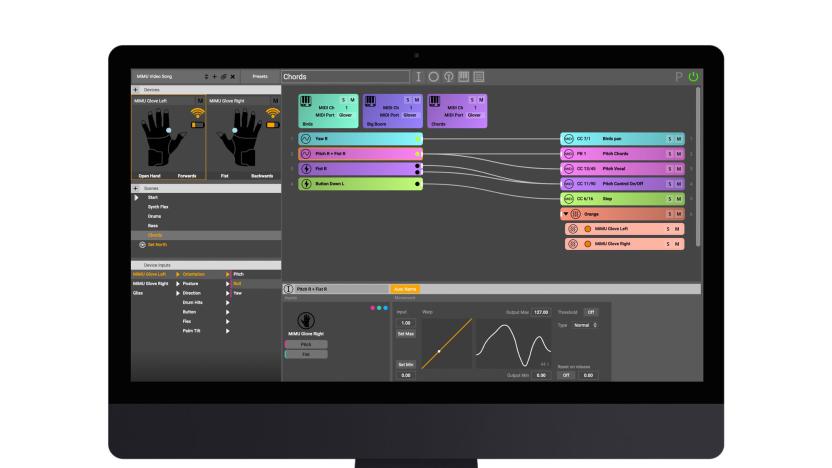
You can now buy the software behind Imogen Heap's musical gloves
Glover was previously only available if you bought the Mi.Mu gloves.
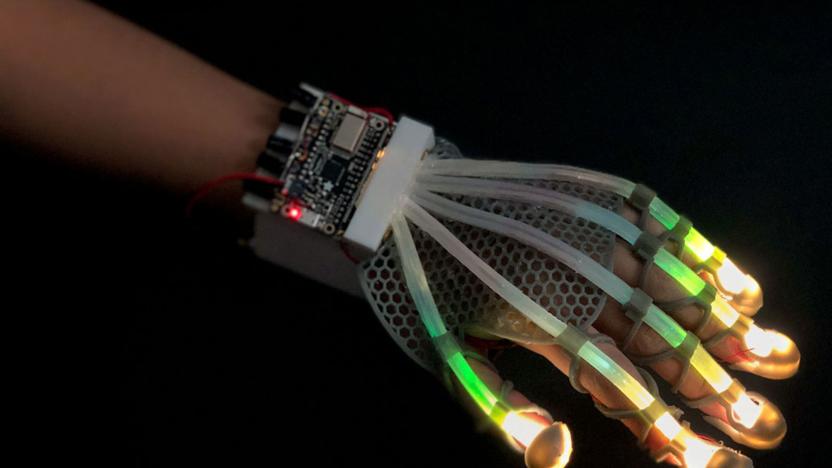
Stretchable skin sensor could help you touch things in VR
Cornell researchers have made a stretchable skin sensor whose light-based approach could bring human-like touch to VR and robots.
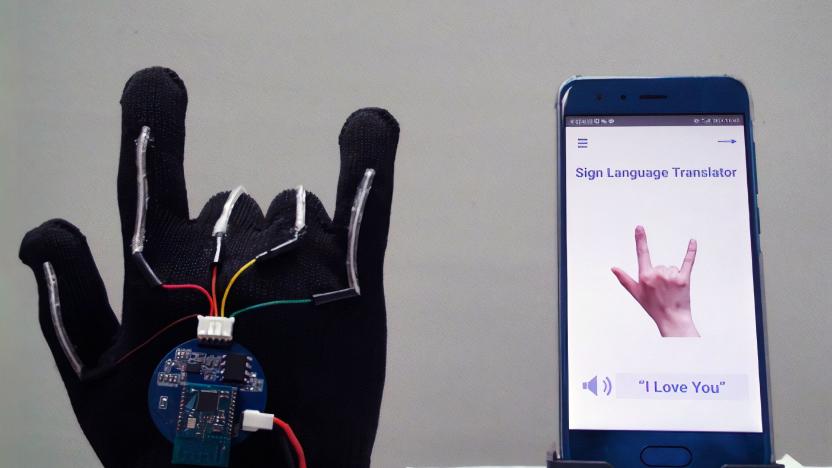
A high-tech glove can translate sign language with 99-percent accuracy
Researchers at UCLA have developed an inexpensive, high-tech glove that can translate sign language into written and spoken words on a smartphone.
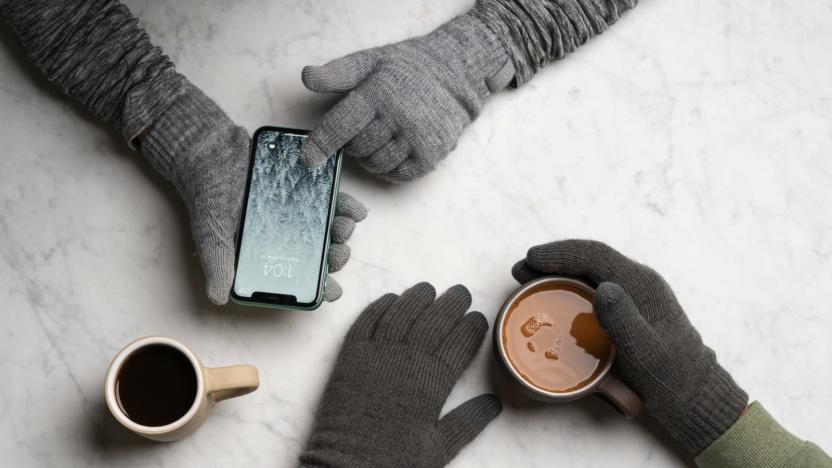
The best touchscreen winter gloves
By Nick Guy, Kaitlyn Wells, and Justin Krajeski This post was done in partnership with Wirecutter. When readers choose to buy Wirecutter's independently chosen editorial picks, Wirecutter and Engadget may earn affiliate commission. Read the full guide to touchscreen winter gloves. The best touchscreen gloves are ones that can differentiate between "texting" and "textjngZ." And after testing 20 more pairs this year, we think the newly redesigned Moshi Digits Touchscreen Gloves are some of the best we've seen of the 80 we've tried overall. They're warm enough, accurate, and can fit a wide range of hand sizes. Although no pair of touchscreen gloves is going to keep your hands perfectly warm or let you type as well as you would with bare fingers, the Moshi Digits were warmer, fit better, and were more accurate in typing tests than the competition. If you want a good pair of touchscreen liner gloves instead, we have a pick for that. If you want a thinner glove for fall weather or prefer the classic look of leather, we also have picks for those. Do keep in mind, though, that ultimately it may be easier to use voice commands and audio messages, rather than trying to type in even the best of these gloves.
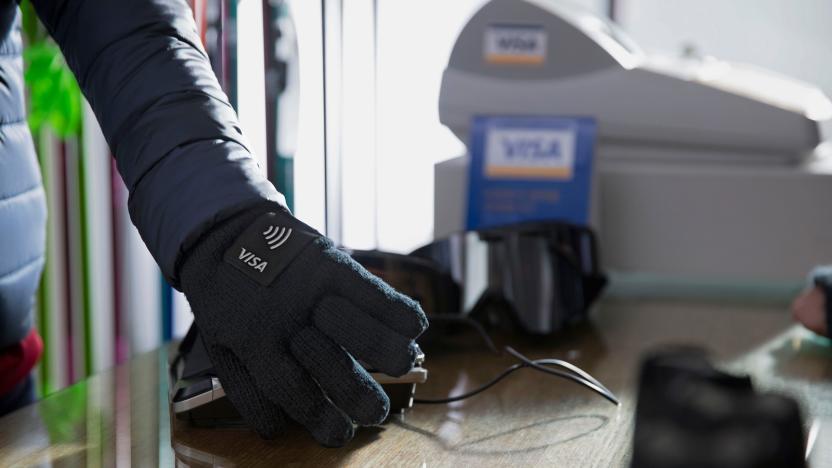
Visa swaps payment cards for NFC gloves at the Winter Olympics
Visa is very fond of showing off its tap-to-pay technology at the Olympics, and that's truer than ever with the 2018 Winter Olympics around the corner. The payment giant is selling a trio of NFC-equipped gadgets to help you shop at the PyeongChang games, most notably a set of winter gloves. Yes, you can pay for that souvenir without freezing your hands as you reach for a credit card or even your phone. You won't have to use them or the other devices at the games, but they'll come with prepaid values of between 30,000KRW to 50,000KRW ($27 to $45) to encourage shopping in South Korea. Visa hasn't offered pricing.

Dexmo exoskeleton glove lets you touch and feel in VR
As much as we enjoy virtual reality these days, there's still the occasional urge to fiddle with virtual objects using just our hands. If all goes well, the upcoming Manus VR glove will be the first to unwrap our hands from controllers, but it'll only provide tactile feedback, meaning you still won't be able to feel the shape nor physical properties of virtual objects. This is where Dexmo comes in: This mechanical exoskeleton glove tracks 11 degrees of freedom of motion and offers variable force feedback for each finger. To put it simply, you'll be able to realistically squeeze a rubber duck in the VR world. Better yet, this seemingly clunky glove claim to be lightweight and also runs wirelessly "for a relatively long time."

Use your fingers to play in Vive's world with the Manus VR glove
The Manus VR glove promises to take handheld controllers out of virtual reality, allowing players to use natural hand and finger motions within immersive, digital spaces. It's compatible with the HTC Vive, taking advantage of that system's Lighthouse positional tracking tech, and pre-orders for its first-ever developer kit open in Q2 this year. The kits cost $250 and should ship in Q3.

Magnets could soon track your fingers in virtual reality
In an ideal world, you'd grab objects in virtual reality with your hands, like you do in real life. However, that's not usually how it works -- outside of some specialized gloves, you're left using abstract controllers. Oculus and University of Washington researchers might make it a reality, though. They've developed Finexus, a control method that uses a combination of fingertip electromagnets and sensors to track your hands. The system detects the distances between each finger and the sensor, and uses the intersection of each distance to determine a given digit's exact 3D position. Unlike with camera tracking, you don't need a direct line of sight to the sensors for this to work -- you could tie your virtual shoelaces if you wanted.

The best touchscreen gloves
This post was done in partnership with The Wirecutter, a list of the best technology to buy. Read the full article below at TheWirecutter.com Over the past three winters, we've tested more than 20 pairs of touchscreen gloves while moving half a ton of stumps, climbing on ice, and just walking and biking around town. For the third year running and despite some stiff competition, the Winter Style Touchscreen Gloves by Glider Gloves are the ones we recommend for most people, offering up the best combination of warmth, dexterity, and grip for about $30 (also available direct). They're not the absolute warmest gloves you can buy, but they're warmer than anything that's better at handling touchscreens and better at handling touchscreens than anything that's warmer.

Home-made vibrating gloves train your finger muscles to touch type (video)
You know what can teach you Braille and piano a lot more quickly than traditional means? Vibrating gloves, or gloves with haptic feedback, if you will. In fact, IEEE Spectrum senior editor David Schneider was so intrigued by the idea, that he put together his own version to serve as a haptic touch-typing tutor for his 11-year-old son. He admits that his gloves (made using transistors, $14 worth of vibration motors purchased from eBay and long cords connecting them to an Arduino Nano board) aren't as sleek as Georgia Tech's piano-teaching ones. But, hey, they worked, and once he created a program to go along with them, they did their job well enough.

Imogen Heap's high-tech gloves could make the rest of your band obsolete
If you thought Michael Jackson was the only musician to believe in the magical power of a glove, think again. Imogen Heap has "joined forces with the nerd underworld" to create a new high-tech glove called Mi.Mu that allows you to control sound with your hands. Using lights and motion sensors, the gloves can map a variety of hand gestures to different instruments and sounds, with each pair able to store literally thousands of combinations. It's a concept she first talked about at TED in 2011.

This liquid can make any glove touchscreen-friendly
It hasn't been all that easy to make your own touchscreen-friendly gloves short of grabbing a needle and some conductive thread. With Tony Yu's upcoming Nanotips, however, it could be as simple as applying touch-up paint. The conductive liquid gives any pair of gloves (and many other surfaces) the same capacitive effect as your own fingers, letting you use your phone no matter what style of handwear you prefer -- you can check email while you're still dressed for a motorcycle ride. If you're intrigued by the idea, you can pledge $22 Canadian ($20 US) to get a bottle of Nanotips Black, which is intended for rubber and other thicker materials. Outside of early bird specials, it costs $30 CAD ($27 US) to get the fabric-oriented Nanotips Blue. Both formulas should reach backers between February and March.

Mujjo leather crochet touchscreen gloves keeps you hands looking good, warm this winter
Knitted touchscreen gloves have been around for a while now. I use a pair every winter so I can use my iPhone outside without my hands getting cold. Knitted touchscreen gloves at first seemed magical when they came out, but the engineering behind them is simple enough: Conductive threads are interwoven with the glove fibers to transmit the electrical signals from your skin to the iPhone's touchscreen. Those that like leather gloves haven't had a whole lot of options, however. Leather touchscreen gloves are often limited to patches of conductive material in a few fingertips that look ridiculous. Well, no more! I've been trying out a pair of Mujjo's Leather Crochet Touchscreen Gloves and they bring the style back to using your iPhone with gloves on. The leather part of Mujjo's gloves (the part that touches the iPhone's touchscreen) is made from Ethiopian lambskin, while the crochet top is made from Egyptian cotton. From outside appearances, these leather gloves look like normal high-quality leather gloves you'd find in any good department store. There are no visible signs in the form of the usual dots of conductive material on their fingertips. Instead, Mujjo has used nanotechnology to integrate the leather with conductive properties allowing them to be readable by the iPhone's touchscreen -- and they work marvelously. Inside, the gloves are lined with cashmere, making them thick and warm on the hands. That's why it's so surprising the first time you put these gloves on and find they can actually control your iPhone. Just as with my regular knitted touchscreen gloves, the iPhone picked up virtually every tap I made with the leather Mujjo gloves on -- even when typing on iOS' tiny keyboard. One word of warning, however: If you are thinking of ordering a pair of these, make sure you order a snug enough fit. If you order them too big, the space between your finger's skin and the interior of the gloves may be too wide to always pick up contact when you touch your screen. Beyond that point, however, the gloves make a great Christmas gift for you or your friends. They're snug, warm and stylish and let you keep using your iPhone even when the snow is falling outside. Mujjo's Leather Crochet Touchscreen Gloves are €89.95 (about US$124.00) and can be ordered from the company's online store.

Nokia Lumia screens tout Synaptics tech for gloves-on use, 920 adds outdoor-friendly brightness
Everyone who regularly deals with cold winters knows the pain of using a smartphone in January -- you're usually forced to take your gloves off and risk frostbite if that call just can't wait. Nokia's new Lumia 820 and Lumia 920 phones bring in a Synaptics ClearPad Series 3 sensor whose responsiveness will keep those hands toasty. Super Sensitive Touch, as Nokia calls it, lets the capacitive surface react to more than just direct skin contact: it can recognize input through gloves, as well as from those with long fingernails. You'll want to spring for the Lumia 920 if you envision updating Twitter during a sunny skiing trip, however. On top of that extra-large 1,280 x 768 resolution, the 920's PureMotion HD+ display is reportedly about 25 percent brighter than its next-best rival. We're looking forward to a real field test -- not to mention preserving all the feeling in our fingers.

Hi-Fun's call-receiving Bluetooth gloves, hands-in (video)
Sometimes the most fascinating bits from a tradeshow come from those booth in between major manufacturers, and while we're certainly not claiming that the Hi-Call is "the best product at IFA" as its spokesperson suggested to us with a smile, they're nothing if not interesting. Hi-Fun's gloves are Bluetooth headsets -- or, well, handsets -- with the speaker built into the thumb and the mic in the pinky, so you can talk by doing the traditional "call me" hand gesture. Pairing is simple enough for anyone who's done the process on a more traditional headset -- the button is built into the top of the glove, along with a button to end the call. We took the gloves for a spin, as you can see in the video below, calling the rep's very confused boss. In spite of turning up the handset volume as loud as possible, we had a lot of trouble actually hearing something on the showfloor -- and the fellow on the other end seemed to be having similar issues, leading to quite probably the first time I've ever used the phrase "I'm sorry, I can't hear you, I'm talking into a glove." Hi-Call will be out in the beginning of October, just in time for the cold weather. It'll run you a not particularly cheap €49 for the pleasure of speaking into your pinky. Video evidence after the break.

Glove Tricorder helps train doctors, may lead to DIY cancer screening
It may look like an early prototype of the Power Glove, but this wearable "tricorder" is not only less embarrassing than the doomed Nintendo peripheral -- it's also quite a bit more advanced technologically. This second prototype of the medical gadget is home to a veritable arsenal of sensors, including an accelerometer, pressure and temperature modules. Eventually, Med Sensation hopes to place ultrasound pads on the fingertips, allowing physicians to peer inside the body while they poke and prod in an attempt to diagnose you. At the moment, the system is better suited for providing feedback -- guiding trainees in the proper techniques for giving exams. Ultimately though, the hope is to put these in (or would that be on?) the hands of average Joes and Janes. Individuals could then check for lumps or enlarged organs at home, without having to spend half the day sitting in a waiting room. For a brief demonstration, check out the video after the break.

Vibrating glove gives piano lessons, helps rehab patients regain finger sensation and motor skills
We've seen a good number of electronic gloves before, and now researchers at Georgia Tech have devised one to rehabilitate patients who suffer from paralyzing spinal cord injuries while teaching them how to tickle the ivories. Christened Mobile Music Touch, the black mitt pairs with a keyboard and cues individual fingers with vibrations to play notes. The handgear also buzzes constantly for several hours to stimulate recovery while users go about their day, similar to another yellowjacket-developed solution. After treatment, some patients could pick up objects and feel textures they hadn't been able to -- especially remarkable since, according to the university, little improvement is typically seen a year after injuries are sustained. Folks who learned to play the piano with the device also experienced better results than those who did without it. Project leader Dr. Tanya Markow believes that the rehab's success could be caused by renewed brain activity that sometimes lies dormant. For the full skinny, head past the break for the press release and a video of the gauntlet in action. [Thanks, Timothy]

ATLAS bimanual-rehabilitation glove system hands-on (video)
The Squid Shirt that we checked out earlier today at Northeastern University certainly has the potential for healthcare use beyond straight off-season workout sessions, but the ATLAS project is an even purer expression of that application. The name is an acronym for the rather unwieldy Angle Tracking and Location At home System. In short, the system is a bimanual-rehabilitation glove system, a tracking device that utilizes two gloves to monitor the hand movements of stroke victims. The "Home System," part of the name, meanwhile, signifies its creators' intention to eventually release the ATLAS as an at-home testing system, allowing users to get more regular readings than industrial versions. The system is comprised of two standard black gloves -- the first version (it's currently on version three), assistant academic specialist Mark Sivak tells us, was comprised of gold lycra gloves. The gloves have bend sensors in each finger and internal measurement sensors on the back of the hand. The bend sensors are anchored on the back of the hand, located beneath a moveable flap. They're embedded in the glove, running down each finger. The hand orientation inertial sensor is comprised of an accelerometer, gyroscope and magnetometer located on a box strapped to the top of the glove. The bend sensors feed straight into a box with an Arduino Mega inside, while the inertial sensors first pass through their own Arduino microcontrollers before rejoining the data feed back to the PC.%Gallery-158061%

Sign language translator turns gestures into spoken letters, makes for a better world (video)
By far one of the greatest challenges of sign language has been to translate it for everyday folk that wouldn't know where to begin a conversation with the deaf. Cornell University engineering students Ranjay Krishna, Seonwoo Lee and Si Ping Wang -- along with some help from Jonathan Lang -- used their final project time this past semester to close this gap in one of the more practical solutions we've seen to date. Their prototype glove uses accelerometers, contact sensors and flex sensors to translate complex finger gestures from the American Sign Language alphabet into spoken letters: after converting hand positions to digital signals, the test unit both speaks out the resulting letters and sends them to a computer, where they can be used for anything from a game (shown in the video below) to, presumably, constructing whole sentences. Along with being accurate, the Cornell work is even designed with a mind towards how it would work in the real world, as the glove and its transmitter are both wireless and powered by 9-volt batteries. We hope that the project leads to a real product and an extra bridge between the deaf and the rest of us, but in the meantime, we'll be happy that at least one form of powered glove is being put to the noblest use possible.

Glove-based CRTouch project turns old monitors into touchscreens
As anyone who's ever played a game of Duck Hunt is aware, there are ways of directly interacting with CRT monitors that don't require any modifications to the display itself (a la resistive overlays). A group of students from the University of Hasselt in Belgium have now taken that idea further than most, however, and developed a glove-based system that uses a pair of phototransistors in the fingertips to detect the electron beam as it makes its way across the screen. While not quite "multitouch," the student's current setup (dubbed CRTouch) does let them draw on the screen with one finger and call up additional options (like an eraser or color palette) with the second. Head on past the break to check it out in action.











